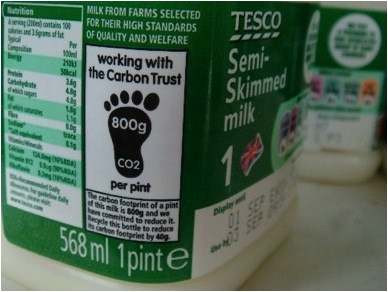The current methods used to measure the carbon footprint of many consumer products fall short of assessing their true environmental impact, according to two studies from Robert Vos of the USC Spatial Sciences Institute.
Carbon labels — which aim to quantify the climate change impacts of a particular item — now appear on everything from beer to breakfast cereal around the world, though they’re not yet widely used in the United States.
Global giants such as Walmart, PepsiCo and Tesco have funded environmental nonprofits to create their own measurement systems and are vying for their carbon label to become the industry standard, Vos said.
Yet, the underlying science and available data aren’t sufficient to provide an accurate impact of even a simple product such as paper, according to the study, which was published in the November issue of the journal Environmental Impact Assessment Review.
Carbon footprint labels should more carefully consider the location of production and the impacts on surrounding land use, Vos said. The process of making paper is just one example.
“As forests are harvested for wood fiber or cleared for agriculture, their ability to act as the planet’s lungs — by absorbing and storing carbon dioxide — is compromised,” Vos explained. “The type of forest and the harvest practices are, hands down, the most crucial thing to measure about any wood-based product.”
Paper is also important because approximately 40 percent of the world’s industrial wood harvest is used to produce paper. The paper industry is the third largest consumer of industrial energy in the United States, and paper accounts for almost one-third of municipal solid waste, Vos found.
Vos and Joshua Newell of the University of Michigan examined the carbon footprint of paper in U.S. and Chinese supply chains and found a radically different impact depending on the forest harvested for the paper — a consideration current labels do not take into consideration.
“When we looked at the global supply chain for paper products, we realized that retailers don’t even know where the paper fiber for the products on their shelves comes from,” Vos said. “The production of paper products in China has exploded, but China has precious little domestic forest land. So they have to import pulp from places such as Indonesia, Chile and Russia, and some of this harvest takes places in ‘frontier forests.’ ”
Is the fiber coming from a managed forest or an unmanaged forest that is clear-cut?
According to some studies, the loss of forests contributes about 20 percent of the total greenhouse gas emissions worldwide every year, a level that rivals transportation.
“We need to do a much better job incorporating the carbon emissions associated with forest-based products to tackle climate change,” Newell said. “From our study, it is clear that from a greenhouse gas emissions perspective, not all paper is created equal. Pulping old-growth tropical forests from Indonesia to make paper just doesn’t make sense. Product carbon footprinting needs to take this into account.”
The study reviews three existing international protocols for measuring carbon footprints and suggests revisions to incorporate management practices of forests. It also recommends a global working group to bring together scientists who model forest carbon with those who measure carbon footprints in consumer products.
“In the long run, Geographic Information System tools would enable us to link the source of wood with an estimate of that specific forests’ ability to store carbon,” Vos said. “We need these tools to move beyond the impoverished and misleading representations of the carbon footprints of the products on supermarket shelves.”
The November study built on the authors’ December 2010 work, which was published in the Annals of the Association of American Geographers.
(See original article here)





